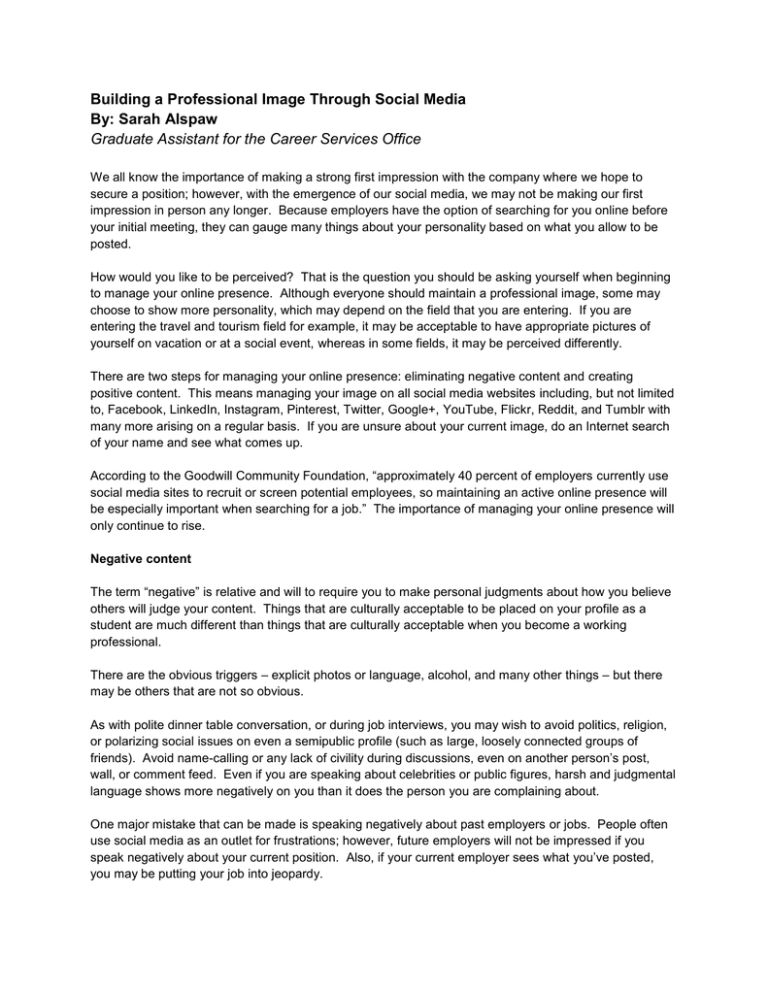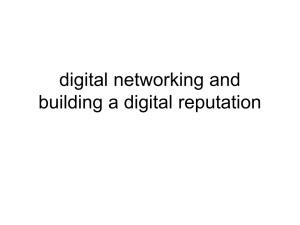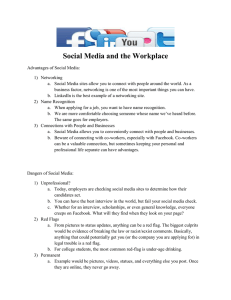Building a Professional Image Through Social Media By: Sarah Alspaw
advertisement

Building a Professional Image Through Social Media By: Sarah Alspaw Graduate Assistant for the Career Services Office We all know the importance of making a strong first impression with the company where we hope to secure a position; however, with the emergence of our social media, we may not be making our first impression in person any longer. Because employers have the option of searching for you online before your initial meeting, they can gauge many things about your personality based on what you allow to be posted. How would you like to be perceived? That is the question you should be asking yourself when beginning to manage your online presence. Although everyone should maintain a professional image, some may choose to show more personality, which may depend on the field that you are entering. If you are entering the travel and tourism field for example, it may be acceptable to have appropriate pictures of yourself on vacation or at a social event, whereas in some fields, it may be perceived differently. There are two steps for managing your online presence: eliminating negative content and creating positive content. This means managing your image on all social media websites including, but not limited to, Facebook, LinkedIn, Instagram, Pinterest, Twitter, Google+, YouTube, Flickr, Reddit, and Tumblr with many more arising on a regular basis. If you are unsure about your current image, do an Internet search of your name and see what comes up. According to the Goodwill Community Foundation, “approximately 40 percent of employers currently use social media sites to recruit or screen potential employees, so maintaining an active online presence will be especially important when searching for a job.” The importance of managing your online presence will only continue to rise. Negative content The term “negative” is relative and will to require you to make personal judgments about how you believe others will judge your content. Things that are culturally acceptable to be placed on your profile as a student are much different than things that are culturally acceptable when you become a working professional. There are the obvious triggers – explicit photos or language, alcohol, and many other things – but there may be others that are not so obvious. As with polite dinner table conversation, or during job interviews, you may wish to avoid politics, religion, or polarizing social issues on even a semipublic profile (such as large, loosely connected groups of friends). Avoid name-calling or any lack of civility during discussions, even on another person’s post, wall, or comment feed. Even if you are speaking about celebrities or public figures, harsh and judgmental language shows more negatively on you than it does the person you are complaining about. One major mistake that can be made is speaking negatively about past employers or jobs. People often use social media as an outlet for frustrations; however, future employers will not be impressed if you speak negatively about your current position. Also, if your current employer sees what you’ve posted, you may be putting your job into jeopardy. Keep an eye on what your friends post onto your profile. Just because you are savvy enough to understand what not to post, does not mean that all of your friends are as knowledgeable. This includes things that are posted directly onto your wall or things you are tagged in, including tweets, statuses, blogs, and pictures. Positive content Allowing viewers to see your personality is not a negative; employers are checking your website to be able to catch a holistic view of you as a person, including your interests and involvement. Posting pictures of your Greek organization doing philanthropy, your friends helping out in the community, or you and your instructors at research conferences can all give a positive image of yourself to future employers. Keep in mind what website you are posting though; Facebook is a great medium to post social pictures, where LinkedIn profile pictures may be more suited for pictures of you at professional conferences or working in an internship. Please see the “Not All Bad: The Positives of Using Social Media” article for other positive uses of social media. Privacy settings For certain websites, it is possible to limit what can be seen by certain friends. Especially on Facebook, it has become easier than ever to pick and choose who will see what content. However, it is still important that you manage what you or your friends post to your wall. Just because you’ve limited someone’s viewing does not clear you from paying attention to the content. Due to the easy ability to take screen shots of your screen, people who are able to see the content on your wall can take a photo and repost it anywhere on the Internet. Some people choose to create two accounts, one for personal use, and one for professional use. Other than the fact that this is a violation of the user agreement that you signed when you registered for your profile, this also does not protect you completely from individuals finding your account. Your account can be found by searching for your email address, city, university or other search parameters. Also, be aware that your facebook profile picture and cover photo are never private. In conclusion, it is important to monitor and edit your presence on any and all social media websites. With the database that stores all of the information that you post onto Facebook into a long-term data drive, you wouldn’t want something that you did in high school or college to become an embarrassing exposé in years to come when you begin securing higher profile leadership positions. Social media can be used as a powerful tool to positively influence your followers, subscribers, peers, and potential employers. With the ability to release any desired content on a whim, individuals must take care to understand the implications of releasing information into the Internet. Career Journal, March 2013, Vol. 10 Issue 2 http://www.wcu.edu/WebFiles/PDFs/13-126_March_Career_Journal.pdf


